
Creatine Monohydrate – 5000 mg
Creatine is a molecule produced in the body that’s made up of three amino acids — methionine, arginine, and glycine. It stores phosphate groups used to help produce adenosine triphosphate (ATP),[4] the body’s main energy carrier and the usable energy source for nearly all cells. Amongst ATP’s numerous roles, it’s heavily used for muscle contractions[5] and intense mental activity.
Thanks to creatine’s supportive role in ATP generation, and ATP’s role in muscle contractions, creatine supports immediate energy production during exercise – especially when muscle glycogen becomes depleted.[6] Supplemental creatine has been shown to boost overall strength and performance in numerous training and sporting scenarios,[7] much of which will be detailed below.
How much creatine do I need?
Your creatine requirements are different for each person but depend on three major factors:
- Your size and muscle mass
- Your diet (specifically meat consumption)
- Your physical activity
The goal is to achieve a saturation of creatine in the muscle tissue so creatine can be deployed as needed during training. This requires a bit of work to determine each person’s individual needs, although there are some general guidelines that suit most athletes:
Creatine storage in the body
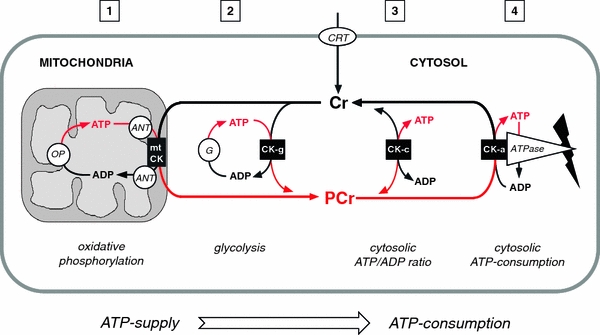
A study published in 2011 does a fantastic job showing creatine’s role in the production of ATP in the mitochondria.[8]
The male body has capacity to store up to 160 grams of creatine.[4] However, the total amount of creatine has been found to be 120 grams in the average man,[4] 95% of which is stored in skeletal muscle tissue. Small amounts are also stored in the brain and reproductive organs.[9]
The excretion of creatine
Humans excrete about 1.6-1.7% of their creatine stores per day.[10,11] This means that on average, males excrete about two grams of creatine per day,[12] although the actual number will depend on size and muscle mass. Women lose a bit less – roughly 80% of men.[12]
Dietary sources of creatine

More of this means less creatine needed to supplement. Image courtesy The Provision House
Much of your creatine needs can be met by your diet, but it will ultimately depend on how much meat you consume. For instance, red meat is the best food-based source of the molecule, with about 2-2.5 grams of creatine per pound of uncooked beef.[13] Chicken comes in a bit lower, with roughly 1.5 grams of creatine per pound.[14]
The final intake strategy: achieve and maintain saturation
All told, this helps paint a picture as to why we want to achieve saturation of creatine in the muscle tissue and then stay at saturation. Older protocols (and several successful studies) in the late 1990s and early 2000s involved loading with 20 grams of creatine per day for 5 days, and then taking 5 grams per day thereon. This still works and will likely help achieve saturation more quickly but is more costly and potentially wasteful, especially in today’s inventory landscape.
Those who are in less of a hurry will generally take 2-5 grams of creatine per day, every day, depending on gender, size, and exercise intensity. Without knowing any other lifestyle or diet details, our simple dosing suggestion is as follows: For women, 2-3 grams per day is a reasonable amount, while men can aim for 3-5 grams per day.
The athletic benefits of creatine
With creatine’s role as a phosphate donor that facilitates ATP production, and ATP’s energetic role throughout the entire body, creatine can have a wide array of health benefits. For the sake of this article, however, we’re focusing on athletic benefits.
There have been hundreds of peer-reviewed studies evaluating the efficacy of creatine supplementation in improving exercise performance, and we can’t possibly cover them all. A 2003 review analyzed roughly 300 studies evaluated creatine’s effect on performance and found creatine supplementation generally leads to 5-15% improvement in the variable of interest.[15]
The rule of 5-15%
Published research has found short-term creatine monohydrate supplementation typically leads to:[15]

The most epic list of creatines you’ll ever seen.[16]
- 5-15% improvement in maximal power/strength
- 5-15% increase work during maximal effort muscular contraction sets
- 5-15% increase in work performed during repeat sprint bouts
- 1-5% improvement in single-effort sprint performance
There have been far more creatine studies published since then, and the results/ benefits are seen across numerous sports and events.
Short-term creatine use
Creatine supplements have supported short-term adaptations such as total work performed on the bench press and jump squat, increased cycling power, and improved sport performance in sprinting, swimming, and soccer.[15,17-23] Studies have also supported creatine’s use in both males and females.[18,24-26]
Long-term creatine use
Further research has shown long-term creatine intake is beneficial to both muscle performance and lean body mass.[21-24,27-29]
Most researchers agree these effects are thanks to an improved ability to perform high levels of intense training thanks to better ATP synthesis. With so many studies conducted on creatine in athletes, the research community is led to conclude it is an incredibly effective and reliable supplement,[16,30] and one we believe that should be in nearly every athlete’s regimen.
Creatine safety

We’ll be getting to HMB next
When creatine supplements first gained popularity in the 1990s, they were mired in controversy and misinformation — much of which still exists to this day. Thankfully, common sense dietary intuition (creatine is naturally found in food) coupled with safety research has prevailed.[30-34]
The most common reported “side effect” of creatine use is weight gain,[33] which is often the intended effect in many athletes. Anecdotal case studies sometimes report dehydration and cramping, but these are not supported in peer-reviewed studies on healthy individuals.[30]
An official position stand published in 2007 by the International Society of Sports Nutrition on creatine supplementation and exercise lists nine major points approved by the Society’s Research Committee, one of which states “There is no scientific evidence that the short- or long-term use of creatine monohydrate has any detrimental effects on otherwise healthy individuals.”[30]
In the years since that position stand was published, there have been no new research studies that indicate the contrary. However, a newer 2022 review cites 255 other articles maintains that creatine monohydrate has “Strong Evidence to Support Bioavailability, Efficacy, and Safety”.[16]
Creatine Monohydrate: The main forms of creatine
There are hundreds of commercially-sold creatine supplements on the market, with over a dozen types of creatine compounds available for brands to use. The most well-established form of creatine is easily creatine monohydrate, though.[35]
It’s the subject of the vast majority of research studies cited above, and consists of each creatine molecule bound to a water molecule, making it 88% creatine by weight.[35]
Our take is that the form of creatine matters less than compliance and dose, but when in doubt, go for the tried-and-true creatine monohydrate.
myHMB (as Calcium β-hydroxy-β-methylbutyrate monohydrate) – 1500 mg
Distributed by the TSI Group, myHMB is a patented form of HMB, which is a metabolite of the branched-chain amino acid L-leucine.
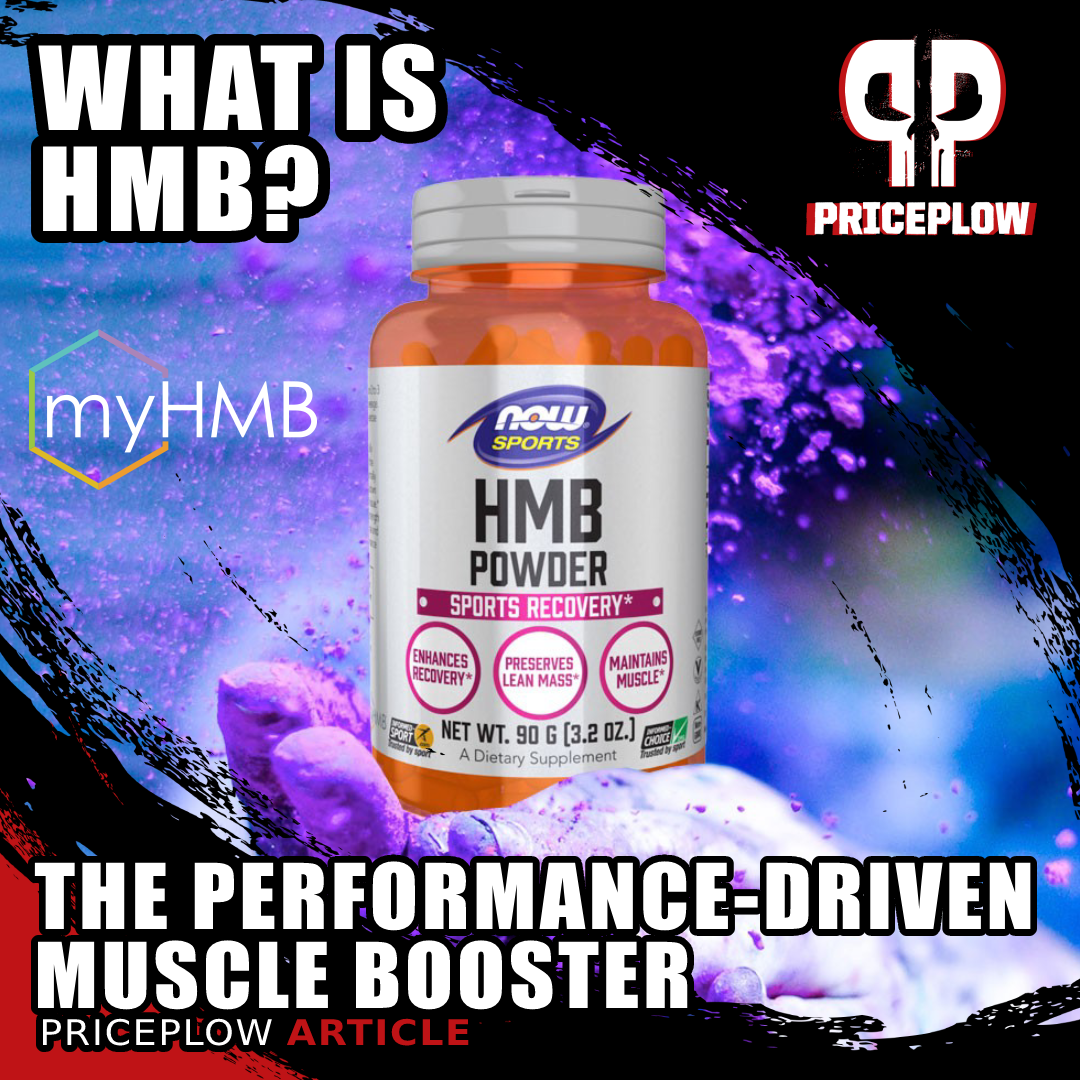
Read the full story in PricePlow’s main HMB Supplements article.
HMB is actually primarily a signaling molecule, shown to activate many of the same “metabolic switches” as leucine, which includes both mTOR (mammalian target of rapamycin)[36] and IGF-1 (insulin-like growth factor 1),[37] both of which are well-known to be anabolic.
Many athletes know of leucine’s anti-catabolic effects (it prevents muscle breakdown),[38-40] but that requires extremely large doses — well into the double-digits of grams.
What we now know is that leucine’s metabolite HMB is largely responsible for those effects, yet only ~5% of leucine is converted to HMB in the best of situations![41] This is where HMB supplementation comes in, to get the effects without needing to eat massive amounts of protein and leucine.
Human research on HMB
HMB’s been around for a while, so we have a great deal of research supporting its use. Here’s what we’ve seen in human subjects taking 1.5-3 grams daily, as collected in the International Society for Sports Nutrition (ISSN)’s position stand:[42]
- Improved muscle and strength gains paired with resistance training[43-45]
- Greater athletic endurance and overall work capacity[46-49]
- Reduced post-workout muscle damage[50,51] and recovery speed[52]
- Promote leaner body composition[53]
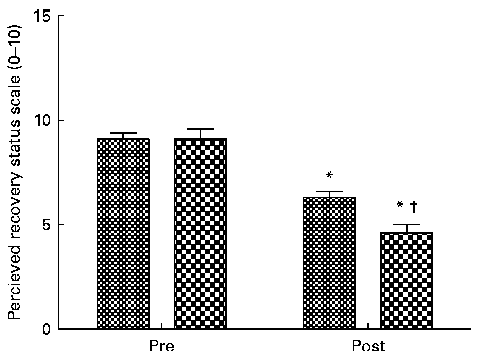
Resistance-trained subjects who took HMB before a high-volume weightlifting session rated their recovery significantly higher 48 hours afterwards, compared to the placebo group.[51]
For instance, one of these studies, published in 2014, was a randomized, double-blinded, placebo-controlled test on resistance-trained males who went through a rigorous three-phase periodized training program with an overreaching cycle.[45] It used 3 grams of HMB per day, which would require two daily servings of BodyTech Elite Creatine + HMB.
The researchers tracked muscle mass, strength (using 1 rep max tests), and hormonal blood markers.
They found that the placebo group gained ~6% total strength, which is a testament to the training program. However, the HMB group gained 17% strength — almost 3x the effect — and they also lost significantly more fat![45]
Preventing muscle-loss and muscle-wasting
Before there were studies on building muscle, it’s also important to note how HMB supports the reduced loss of muscle in demographics where this is of critical importance. This was demonstrated in a 10-day study with older adults on bed rest, where 3 daily grams of calcium HMB significantly reduced the loss of lean body mass.[54]
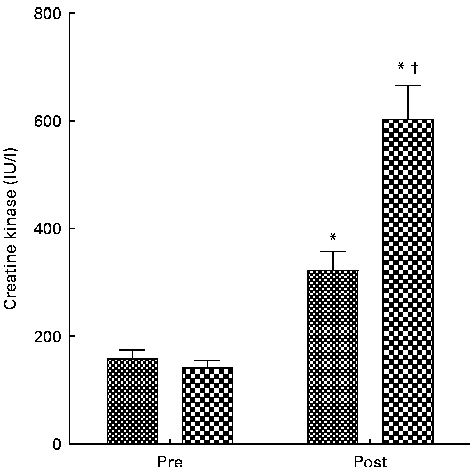
Resistance-trained subjects who took HMB before a high-volume weightlifting session had significantly lower blood levels of creatine kinase (CK), a marker of muscle damage, following the session. The bars with larger checkering represent the placebo group; the bars with finer checkering represent the HMB group.[51]
Over time, more data has come to support HMB’s use in injury and sickness — a meta-analysis published in 2015 concluded that HMB supports significant reductions of muscle loss during aging, especially when it comes to injury, sickness, or those who are bedridden.[55]
Other studies in elderly subjects found significantly increased strength over placebo when using HMB combined with resistance training.[56,57]
We get into the mechanisms in our main article titled HMB (β-hydroxy β-methylbutyrate): Performance-Driven Muscle Supplement. However, it’s important to note a few things regarding the direction of HMB research:
Some caveats and research discretion:
There are two caveats when it comes to HMB and the research cited above. It’s important to honestly discuss them:
-
In terms of building muscle, HMB works best in aggressive training programs
HMB is pretty well-documented to prevent muscle-wasting, but there are some cases where it did not generate muscle gains on its own. This is discussed in the ISSN’s position stand, which makes the following statement:[42]
“…research [on HMB effectiveness] indicates that in trained populations it is critical that the exercise stimulus is of adequate intensity and volume to cause skeletal muscle damage. If these conditions are lacking, HMB is not likely to be efficacious.”[42]
At this point, we’re pretty comfortable stating that HMB is going to work best for those who repeatedly train to true soreness. You can still use it if you’re just doing a standard 3 sets of 10 without much push to failure or periodized training, but that’s not where this ingredient accels.
-
There is some fraudulent research on PubMed that still hasn’t been retracted
Brought to our attention in PricePlow Podcast Episode #093 with HMB researcher Shawn Baier, there’s sadly some research published on “HMB” that was actually using a fraudulent supplement that didn’t have any HMB in it at all!

Shawn Baier joins PricePlow Podcast Episode #093 to talk HMB.
This happened in 2010, where three researchers published a study claiming that an over-the-counter supplement with “3 grams of HMB plus α-ketoisocaproic acid” did not work compared to placebo.[58] Those results made no sense, however, so another team of HMB researchers bought the product used in that study, had it tested, and realized it contained no HMB![59]
After writing a letter to the journal (the Journal of Strength and Conditioning Research),[59] the original researchers admitted to their faulty study and that the product indeed contained no HMB,[60] but never retracted the original study! While their admission of guilt is admirable, this study still lies on PubMed without a red flag retraction notice, and this is a shame because it has swayed some individuals from using HMB… even though it wasn’t even using the ingredient!
We hope that at some point, that study will be retracted by the authors or the journal.
The above story is the reason why TSI Group’s myHMB is the only HMB to trust. When it comes to training this hard, there’s no point in squandering potential gains.
You can learn more in our podcast with HMB researcher Shawn Baier and our article titled HMB (β-hydroxy β-methylbutyrate): Performance-Driven Muscle Supplement.
We’re not done yet though — there’s even more research involving Vitamin D — so let’s get to that next:
Vitamin D3 (as cholecalciferol) – 12.5mcg (500IU) (63% DV)
While many supplement Vitamin D3 over the winter as sunlight gets more dim, that’s not why it’s in BodyTech Elite’s Creatine + HMB!
Early on, HMB researchers noticed that some older individuals did not respond as well to HMB as others.[61] Upon investigation, they noticed that many had poor metabolic status, and one biomarker of note is that they had low serum Vitamin D3 levels![62] Those who had low vitamin D levels did not respond, while those were were sufficient did far better![62]
This is explained around the 1:05:00 mark in our podcast with HMB researcher Shawn Baier.
To verify if supplementing additional vitamin D3 would help in these situations, researchers conducted a double-blind, randomized, placebo controlled study in elderly individuals with low vitamin D status that lasted 12 months.[63]
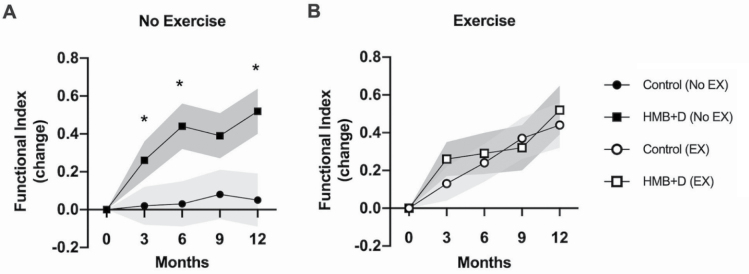
Elderly adults who supplemented with a combination of HMB and vitamin D made significant gains on a muscle function index compared to the control group. The effect size was approximately equivalent to that achieved by a resistance training program.[63]
They randomized individuals into created four groups:
- HMB + Vitamin D + Exercise (resistance training)
- HMB + Vitamin D
- Placebo + Exercise (resistance training)
- Placebo (no resistance training)
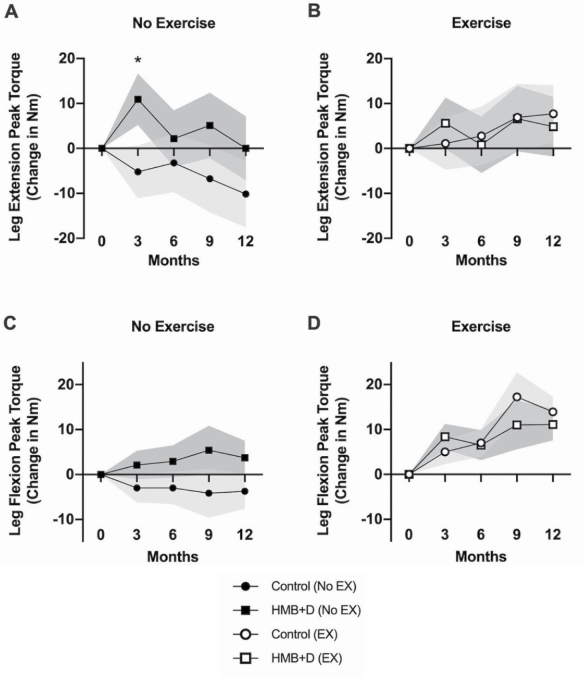
Compared to the non-exercising placebo group, the non-exercising HMB + vitamin D group gained significant leg flexion torque. Although HMB+vitamin D with no exercise did not significantly increase leg extension torque through month 12 of the study, the non-exercise control group actually lost leg extension torque, while HMB + vitamin D preserved it.[63]
What they found is that the adults who supplemented the combination of HMB + Vitamin D had significant gains in muscle function compared to the control group.
Interestingly, the HMB + Vitamin D group that had no exercise also gained strength and muscle function – significantly more than the non-exercising placebo group![63]
In terms of peak torque on leg flexion and leg extensions, HMB + Vitamin D + Exercise had the greatest benefits. Sad but not unexpected, the non-exercise placebo group lost strength.
While this is a study in older individuals, it shows that there could be some solid synergy here for those who have low vitamin D status. It’s always, of course, important to get enough sunshine and reduce exposure to vitamin D’s antagonists, but this is a nice little backup plan.
Additional research in women published in 2022 also showed a synergistic combination of vitamin D and HMB.[64] What’s great about this study is that the women who had enough vitamin D in the first place still responded well, further backing HMB’s efficacy up since they didn’t have a vitamin D deficiency to correct.







